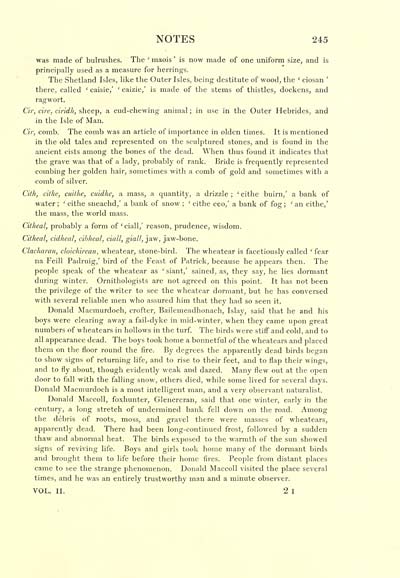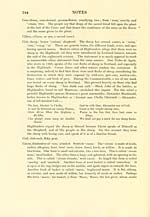Blair Collection > Carmina gadelica > Volume 2
(265)
Download files
Complete book:
Individual page:
Thumbnail gallery: Grid view | List view

NOTES 245
was made of bulrushes. The ' maois ' is now made of one uniform size, and is
principally used as a measure for herrings.
The Shetland Isles, like the Outer Isles, being destitute of wood, the ' ciosan '
there, called ' caisie,' ' caizie,' is made of the stems of thistles, dockens, and
ragwort.
Cir, cire, ciridh, sheep, a cud-chewing animal ; in use in the Outer Hebrides, and
in the Isle of Man.
Cii; comb. The comb was an article of importance in olden times. It is mentioned
in the old tales and represented on the sculptured stones, and is found in the
ancient cists among the bones of the dead. When thus found it indicates that
the grave was that of a ladj', probably of rank. Bride is frequently represented
combing her golden hair, sometimes with a comb of gold and sometimes with a
comb of silver.
Cith, cithe, cuitlie, cuidhe, a mass, a quantit}', a drizzle ; ' cithe buirn,' a bank of
water ; ' cithe sneachd,' a bank of snow ; ' cithe ceo,' a bank of fog ; ' an cithe,'
the mass, the world mass.
Citheal, probably a form of ' ciall,' reason, prudence, wisdom.
Citheal, cidheal, cibheal, ciall, giall, jaw, jaw-bone.
Clacharan, cloichirean, wheatear, stone-bird. The wheatear is facetiously called ' fear
na Feill Padruig,' bird of the Feast of Patrick, because he appears then. The
people speak of the wheatear as ' siant,' sained, as, they say, he lies dormant
during winter. Ornithologists are not agreed on this point. It has not been
the privilege of the writer to see the wheatear dormant, but he has conversed
with several reliable men who assured him that they had so seen it.
Donald Macmurdoch, crofter, Bailemeadhonach, Islay, said that he and his
boys were clearing away a fail-dyke in mid-winter, when they came upon great
numbers of wheatears in hollows in the turf. The birds were stiff and cold, and to
all appearance dead. The boys took home a bonnetful of the wheatears and placed
them on the floor round the fire. By degrees the apparently dead birds began
to show signs of returning life, and to rise to their feet, and to flap their wings,
and to fly about, though evidently weak and dazed. Many flew out at the open
door to fall with the falling snow, others died, while some lived for several days.
Donald Macmurdoch is a most intelligent man, and a very observant naturalist.
Donald MaccoU, foxhunter, Glencreran, said that one winter, early in the
century, a long stretch of undermined bank fell down on the road. Among
the debris of roots, moss, and gravel there were masses of wheatears,
apparently dead. There had been long-continued frost, followed by a sudden
thaw and abnormal heat. The birds exposed to the warmth of the sun showed
signs of reviving life. Boys and girls took home many of the dormant birds
and brought them to life before their home fires. People from distant places
came to see the strange phenomenon. Donald MaccoU visited the place several
times, and he was an entirely trustworthy man and a minute observer.
VOL. II. 2 I
was made of bulrushes. The ' maois ' is now made of one uniform size, and is
principally used as a measure for herrings.
The Shetland Isles, like the Outer Isles, being destitute of wood, the ' ciosan '
there, called ' caisie,' ' caizie,' is made of the stems of thistles, dockens, and
ragwort.
Cir, cire, ciridh, sheep, a cud-chewing animal ; in use in the Outer Hebrides, and
in the Isle of Man.
Cii; comb. The comb was an article of importance in olden times. It is mentioned
in the old tales and represented on the sculptured stones, and is found in the
ancient cists among the bones of the dead. When thus found it indicates that
the grave was that of a ladj', probably of rank. Bride is frequently represented
combing her golden hair, sometimes with a comb of gold and sometimes with a
comb of silver.
Cith, cithe, cuitlie, cuidhe, a mass, a quantit}', a drizzle ; ' cithe buirn,' a bank of
water ; ' cithe sneachd,' a bank of snow ; ' cithe ceo,' a bank of fog ; ' an cithe,'
the mass, the world mass.
Citheal, probably a form of ' ciall,' reason, prudence, wisdom.
Citheal, cidheal, cibheal, ciall, giall, jaw, jaw-bone.
Clacharan, cloichirean, wheatear, stone-bird. The wheatear is facetiously called ' fear
na Feill Padruig,' bird of the Feast of Patrick, because he appears then. The
people speak of the wheatear as ' siant,' sained, as, they say, he lies dormant
during winter. Ornithologists are not agreed on this point. It has not been
the privilege of the writer to see the wheatear dormant, but he has conversed
with several reliable men who assured him that they had so seen it.
Donald Macmurdoch, crofter, Bailemeadhonach, Islay, said that he and his
boys were clearing away a fail-dyke in mid-winter, when they came upon great
numbers of wheatears in hollows in the turf. The birds were stiff and cold, and to
all appearance dead. The boys took home a bonnetful of the wheatears and placed
them on the floor round the fire. By degrees the apparently dead birds began
to show signs of returning life, and to rise to their feet, and to flap their wings,
and to fly about, though evidently weak and dazed. Many flew out at the open
door to fall with the falling snow, others died, while some lived for several days.
Donald Macmurdoch is a most intelligent man, and a very observant naturalist.
Donald MaccoU, foxhunter, Glencreran, said that one winter, early in the
century, a long stretch of undermined bank fell down on the road. Among
the debris of roots, moss, and gravel there were masses of wheatears,
apparently dead. There had been long-continued frost, followed by a sudden
thaw and abnormal heat. The birds exposed to the warmth of the sun showed
signs of reviving life. Boys and girls took home many of the dormant birds
and brought them to life before their home fires. People from distant places
came to see the strange phenomenon. Donald MaccoU visited the place several
times, and he was an entirely trustworthy man and a minute observer.
VOL. II. 2 I
Set display mode to: Large image | Transcription
Images and transcriptions on this page, including medium image downloads, may be used under the Creative Commons Attribution 4.0 International Licence unless otherwise stated. ![]()
| Early Gaelic Book Collections > Blair Collection > Carmina gadelica > Volume 2 > (265) |
|---|
| Permanent URL | https://digital.nls.uk/75840013 |
|---|
| Description | Volume 2. Uibe (incantations) Measgain (miscellaneous) Notes. Names of the reciters of the poems. |
|---|---|
| Shelfmark | Blair.62 |
| Attribution and copyright: |
|
| Description | A selection of books from a collection of more than 500 titles, mostly on religious and literary topics. Also includes some material dealing with other Celtic languages and societies. Collection created towards the end of the 19th century by Lady Evelyn Stewart Murray. |
|---|
| Description | Selected items from five 'Special and Named Printed Collections'. Includes books in Gaelic and other Celtic languages, works about the Gaels, their languages, literature, culture and history. |
|---|

